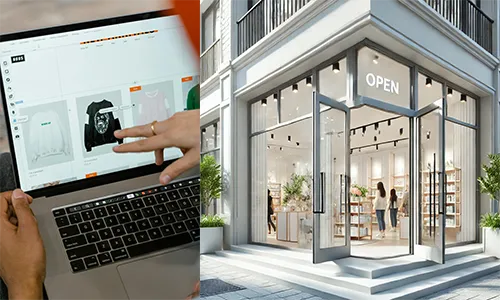
Blending Traditional and Digital Marketing
To attract new customers, brick‑and‑mortar stores must create a vibrant and engaging presence, both physically and online. This often means doing twice the work an online‑only store must do. One effective method is to host community events. For example, “Roger’s Auto Body,” (see right panel), a family‑owned shop, hosted bi‑monthly car shows, which quickly became a community favorite. These events, complete with food trucks and live music, drew in potential customers and fostered a sense of community. They leveraged the fact that auto‑body shops by definition have to have a physical presence, allowing them to use these car shows to deeply engage with their community.
Another key strategy is leveraging social media. A strong social media presence, showcasing stunning visuals and customer testimonials, can attract younger audiences. Partnering with industry influencers can also be effective, offering complimentary products or discounts in exchange for promotional posts. Additionally, a content‑rich blog can boost your business’s online visibility and attract potential customers by sharing tips your product or service’s audience cares about, or providing suggestions of hidden gems specific to the area, further leveraging your retail location.
Retail Business Focus: Why an Auto Body Business Needs a Website

You might wonder why a business like an auto body repair shop needs a website. After all, if the business just places themselves in Google My Business so they get found on Google maps, and has a Facebook page with an email address and a phone number, isn’t that enough?
This setup will get the business customers, especially those that have been in a car accident and need their car fixed right away, but can they do better? What about the customer that has a classic car they’ve been considering restoring for a few years? In other words, high value jobs that are not urgent. How can an auto body business engage with that customer and get their business?

- Gather contact information from those without urgent auto body needs by offering valuable auto body tips
- Once the email address is captured, send educational content to increase the urgency for the person to act, like the dangers of allowing an old car to sit for long periods of time or testimonials of other owners that had their classic cars restored.
- Offer discounts to this audience when the business needs customers, like during a slow time or holiday.
Because the auto body shop has its own website and a way to gather prospects with longer-term, non-urgent work and not just customers needing urgent auto body work, they can acquire more business, smooth out slow business periods, and increase revenues.
Creating Memorable Shopping Experiences
To keep customers coming back, brick‑and‑mortar stores must transform casual shoppers into devoted regulars. This can be achieved through personalized customer service, building trust and continued engagement. For example, a clothing boutique could provide personalized styling advice based on body type and preferences. Implementing a “Wear and Share” program where customers can rent high‑end items can build trust in product quality. Creating a sustainability pledge, detailing the commitment to ethical sourcing and environmentally friendly practices, can also resonate with customers. Building a mailing list of customers as they make purchases, then using a CRM to reach out to customers periodically with interesting content, new product offerings, loyalty program features, and company news can maintain your retail store’s ability to remain top‑of‑mind with your customers.
Strategies for Different Retail Businesses
The strategies for attracting and retaining customers should be tailored to your specific type of retail business.
.
.
Grocery Stores
Implement a “Local Farmer Spotlight” program that emphasizes the fact that your business has a physical location, offer transparent pricing emphasizing local farm sources that cut out distributors (thereby lowering prices), implement a loyalty program, and provide a generous satisfaction guarantee.
Coffee shops
Offer “Community Coffee” meetings where you provide free coffee and encourage discussions about neighborhood topics, create a loyalty program that donates to local community projects, train staff to recognize regular guests and empower staff to resolve disputes quickly.
Bakeries
Healthcare facilities
Hair Salons
Auto repair shops
Entertainment venues
Movie theaters should offer a solid “Satisfaction Guarantee,” bowling alleys could offer a loyalty program that reminds customers of promotions and discounts, and hotels should provide 24/7 customer support.
Professional services
Public services
Building Trust and Community
Several strategies can help build trust and a sense of community:
- Transparency: Offer transparent pricing policies with no hidden fees.
- Guarantees: Provide satisfaction guarantees with easy returns or refunds.

- Feedback: Create a customer feedback system to listen to and act on customer input.
- Community Events: Host regular community events and fundraisers to support local causes.
- Personalization: Train staff to recognize regular guests and remember their preferences.
- Testimonials: Showcase customer testimonials and success stories.
- Loyalty programs: Implement loyalty programs that reward frequent shoppers.
The Importance of Personal Connection
In a digital world, people crave authentic experiences and human connections. By offering personalized care, quality work, and a sense of community, brick-and-mortar businesses can thrive. It’s much less expensive and more lucrative to sell to a former customer than to get a new one. Following up with customers after their service is completed and encouraging online reviews can further build trust and engagement.
By focusing on both acquisition and retention, brick-and-mortar retailers can create a resilient customer base that ensures long-term success. This involves a combination of strategic marketing, creating memorable experiences, and building a strong sense of community.
